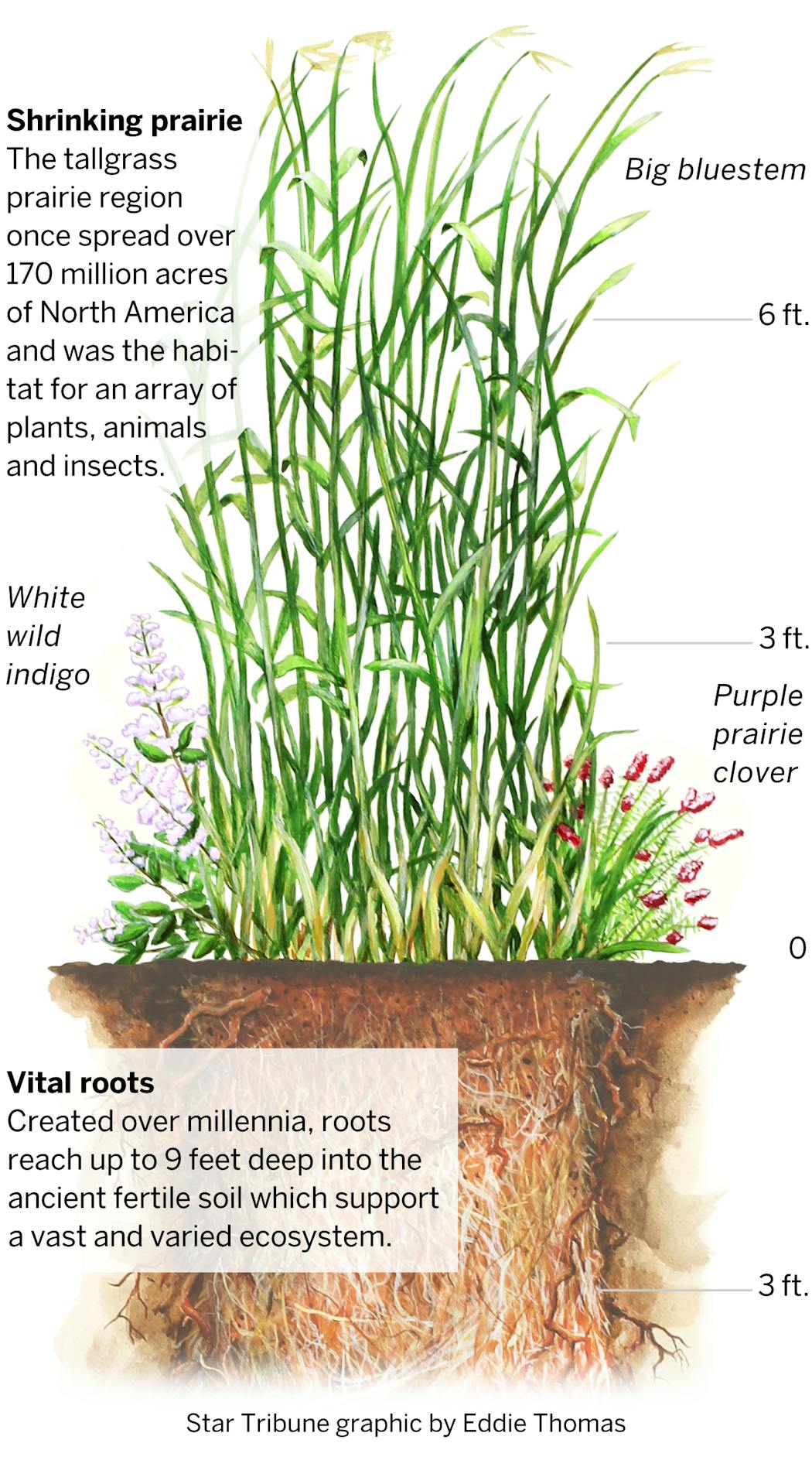Restoring former farmland: 'The system doesn't just bounce back'
It's been more than 91 years since the last crop was pulled from the soil of an old farm field that, hidden away in a science reserve just north of the Twin Cities, has been left to grow wild.
But the soil still hasn't recovered.
Now that field is being studied by researchers from the University of Minnesota who are trying to understand the remarkable underground biology that once made North America's grasslands one of the world's richest ecosystems. And, in the process, understand what it would take to restore that lost ecology.
What they've found so far is that former farmland is only half as productive — growing native grasses and wildflowers in half the abundance, numbers and total weight — as corners of the property that were never plowed. Many native plant species have never returned and likely never will.
The researchers found that even now, nearly a century after the field went fallow, the soil's complex web of microbes, fungi, bacteria, nutrients and carbon, which are fundamental to plant life, are still so depleted from the field's relatively brief time as a farm that it would take another 700 years to fully recover.
"The system doesn't just bounce back," said Forest Isbell, the study's co-author and assistant professor at the U.
The study, published in a recent issue of the journal Nature Ecology & Evolution, highlights the immense challenge that conservation advocates in Minnesota and much of the Midwest face as they try to retire farmland and restore prairies.
Farmland retirement programs are at the heart of the bulk of Minnesota's efforts to capture carbon to combat climate change and to restore habitat to stem the collapse of bee, pollinator and other wildlife populations. But it turns out that the fertility and richness of that soil took centuries to build through hundreds of species of plants living, dying and decomposing. Once the fertility is gone, there is no quick way to bring it back.
Conservationists are only beginning to understand the importance of soil health and plant diversity in recovery programs.
For years, starting in the 1980s, the thought behind hugely popular government conservation efforts, such as the Conservation Reserve Program, was to just get grass in the ground — period, said Greg Hoch, prairie wildlife team leader for the Minnesota Department of Natural Resources. In the haste to restore grasslands, it wasn't uncommon to plant prairie grasses that had been harvested from other parts of the Midwest.
"People were so desperate to find grass they'd look anywhere, so you'd see seeds from western Nebraska get planted in central Illinois," Hoch said. "Well, there is just so much more moisture in Illinois and the grass went crazy."
State programs started requiring landowners to plant native grasses along with one or two types of wildflowers.
Still, many of the fields failed to thrive. Native plants would die out or lose in competition to exotic species that are better suited for the fertilizer that can blow in and rain down from other farms. Grasses would strangle out wildflower seeds brought in from hundreds of miles away rather than grow with them.
Only in the last decade have restoration efforts turned to what is happening below the ground, Hoch said.
That research became especially urgent, he said, because of public concern over the drastic fall of native bee and pollinator populations in the past few years.
Minnesota's honeybee and native bee populations have been cut to a fraction over the past 20 years, while monarch butterflies have fallen by at least 70% across the continent.
Up the food chain, once-common prairie birds such as redheaded woodpeckers have been nearly wiped out of Minnesota, along with hibernating bats and other species.
The main culprit over and over again is some combination of a loss of habitat, a loss of food along with increased pesticide use or an introduction of disease.
Grasslands dominated by one or two species of grass simply aren't enough for Minnesota wildlife to flourish. Pollinators alone rely on dozens, if not hundreds, of species of wildflowers that bloom at different points throughout the year, Hoch said. It takes a robust soil to support that kind of plant diversity.
It's still something of a mystery exactly what it takes to restore soil health, but the surest path to success seems to be to rely on hyperlocal plants and seeds that have stood the test of time in a particular climate, he said.
Restored farms that tend to be the most resilient are those planted with as wide a variety of seeds as possible from the nearest pockets of native prairie or grasslands.
The problem is that in places such as south central Minnesota, any pockets of natural grasslands have long since been plowed over. Hyperlocal seeds are nearly impossible to find.
The U's findings show that passively waiting for plant and animal life to return is a missed opportunity, Isbell said.
Less plant life means fewer nutrients are being captured and retained in the ground, he said. Those nutrients instead run off the land with rainfall or snowmelt and pollute water and air.
With fewer species, the grasslands become more vulnerable to extreme weather, when the remaining species are unable to bounce back from drought, flooding or pests. The lack of food is one more stress on pollinators — and all the benefits they provide to crops — and will only support fewer of them.
"All of the many, many benefits we get from nature are enhanced by diversity," Isbell said. "We have these huge areas of the Earth and in the state that are slowly recovering from agriculture and we're just not getting as many benefits as we could."

